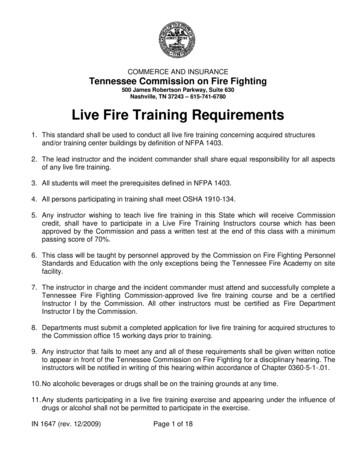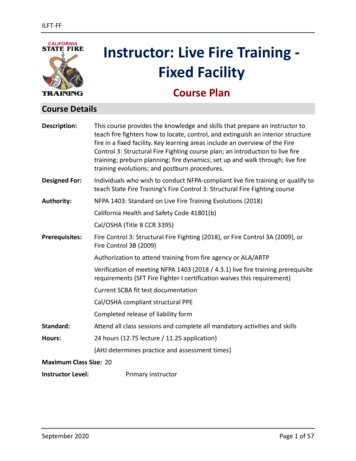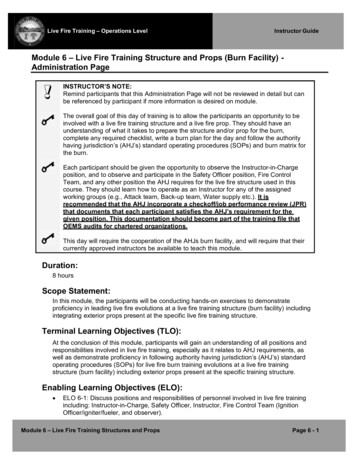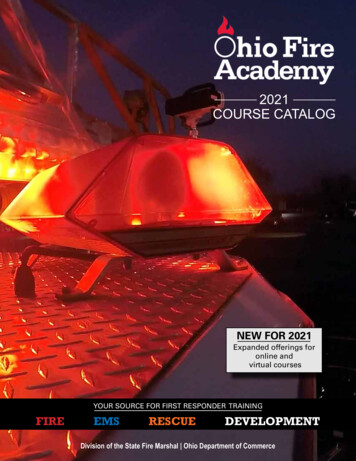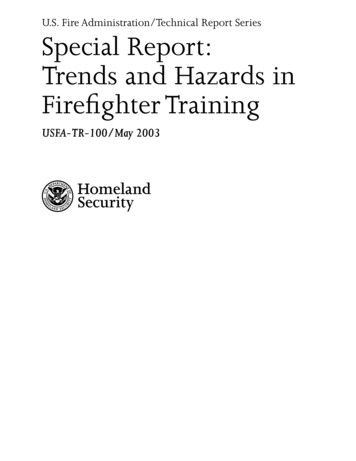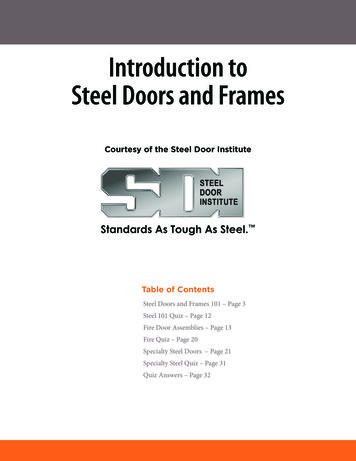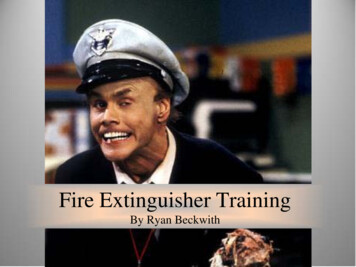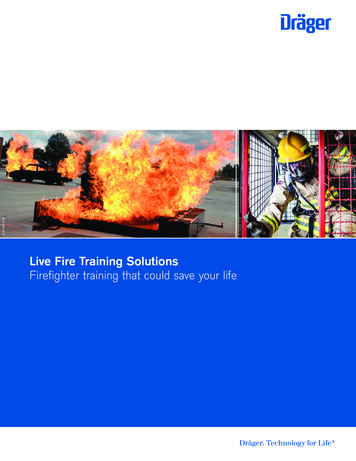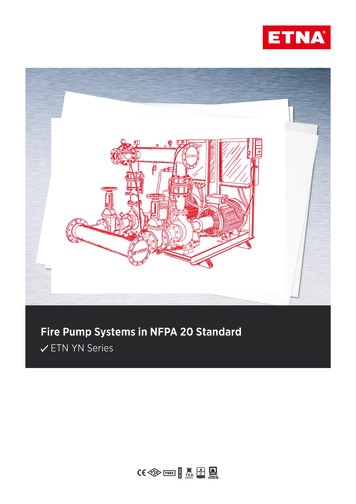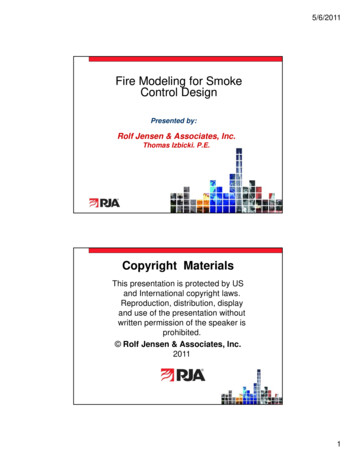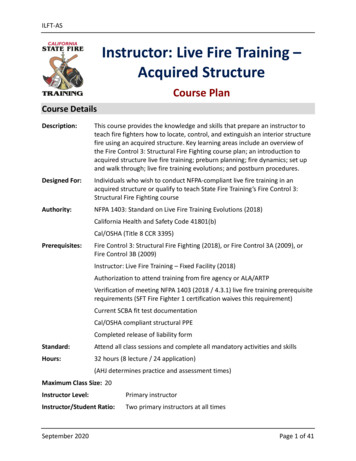
Transcription
ILFT-ASInstructor: Live Fire Training –Acquired StructureCourse PlanCourse DetailsDescription:This course provides the knowledge and skills that prepare an instructor toteach fire fighters how to locate, control, and extinguish an interior structurefire using an acquired structure. Key learning areas include an overview ofthe Fire Control 3: Structural Fire Fighting course plan; an introduction toacquired structure live fire training; preburn planning; fire dynamics; set upand walk through; live fire training evolutions; and postburn procedures.Designed For:Individuals who wish to conduct NFPA-compliant live fire training in anacquired structure or qualify to teach State Fire Training’s Fire Control 3:Structural Fire Fighting courseAuthority:NFPA 1403: Standard on Live Fire Training Evolutions (2018)California Health and Safety Code 41801(b)Cal/OSHA (Title 8 CCR 3395)Prerequisites:Fire Control 3: Structural Fire Fighting (2018), or Fire Control 3A (2009), orFire Control 3B (2009)Instructor: Live Fire Training – Fixed Facility (2018)Authorization to attend training from fire agency or ALA/ARTPVerification of meeting NFPA 1403 (2018 / 4.3.1) live fire training prerequisiterequirements (SFT Fire Fighter 1 certification waives this requirement)Current SCBA fit test documentationCal/OSHA compliant structural PPECompleted release of liability formStandard:Attend all class sessions and complete all mandatory activities and skillsHours:32 hours (8 lecture / 24 application)(AHJ determines practice and assessment times)Maximum Class Size: 20Instructor Level:Primary instructorInstructor/Student Ratio:Two primary instructors at all timesSeptember 2020Page 1 of 41
ILFT-ASAdditional requirements (per NFPA 1403) One instructor for each functional crew of five studentsOne instructor for each backup lineOne additional instructor for each additional functionalassignmentRestrictions:See Facilities, Equipment, and Personnel requirements (page 5)SFT Designation:FSTEPSeptember 2020Page 2 of 41
ILFT-ASTable of ContentsRequired Resources. 4Instructor Resources . 4Online Instructor Resources. 4Student (Instructor Trainee) Resources . 5Facilities, Equipment, and Personnel . 5Time Table . 7Time Table Key . 8Unit 1: Introduction . 9Topic 1-1: Orientation and Administration . 9Unit 2: Review of Fire Control 3: Structural Fire Fighting . 10Unit 3: Introduction to Live Fire Training . 12Topic 3-1: NFPA Standards and Legal Considerations . 12Topic 3-2: Cardiovascular and Thermal Strain of Fire Fighting . 13Topic 3-3: Developing an Incident Within an Incident (IWI) Plan . 14Unit 4: Preburn Planning. 15Topic 4-1: Conducting an Initial Site Evaluation. 15Topic 4-2: Developing a Comprehensive Burn Plan (“Burn Book”). 17Topic 4-3: Conducting Preburn Preparations. 19Topic 4-4: Preparing an Acquired Structure. 21Topic 4-5: Fire Behavior in an Acquired Structure . 23Unit 5: Set Up and Walk Through. 26Topic 5-1: Implementing an Incident Action Plan. 26Topic 5-2: Securing a Water Supply. 27Topic 5-3: Conducting an Instructor Briefing and Preburn Walk Through. 28Topic 5-4: Building Fuel Packages. 30Topic 5-5: Conducting a Student Preburn Walk Through. 31Unit 6: Delivering Live Fire Training Evolutions in an Acquired Structure . 32Topic 6-1: Operating as Instructor in Charge (Command and Control) . 32Topic 6-2: Safety Operations . 33Topic 6-3: Igniting Fuel Packages . 35Topic 6-4: Reviewing Required Fire Control 3 Skills Exercises in an Acquired Structure . 36Topic 6-5: Reviewing Optional Fire Control 3 Skills Exercises in an Acquired Structure. 37Unit 7: Postburn Procedures. 38Topic 7-1: Postburn Procedures . 38Acknowledgments. 39How to Read a Course Plan. 40September 2020Page 3 of 41
ILFT-ASRequired ResourcesInstructor ResourcesTo teach this course, instructors need: Live Fire Training: Principles and Practice(Jones & Bartlett Learning, 1st ed. revised, ISBN: 978-1-284-04123-1) 3D Fire Fighting: Training, Techniques, and Tactics(Fire Protection Publications, Oklahoma State University, 1st ed., ISBN: 0-87939-258-4)Additional recommended resources: Enclosure Fires (Lars-Göran Bengtsson)Available for download at: ationsfrom-the-SRSA/Enclosure-fires/Online Instructor ResourcesThe following instructor resources are available online aining/instructor-registration/ Fire Control 3: Structural Fire Fighting course plan (and supporting documentation)o Instructor Demonstration 1 – Dust Explosiono Instructor Demonstration 2 – Combustiono Instructor Demonstration 3 – Pyrolysiso Props and Structures – Matrixo Props and Structures – Acquired Structureo Props and Structures – Container (Class A)o Props and Structures – Fixed Facility (Class A)o Props and Structures – Gas-Fired Propo Props and Structures – Scalable Burn Propo Skills Exercise 1 – Combustiono Skills Exercise 2 – Risk Assessment and Door Entryo Skills Exercise 3 – Stretching, Flaking, and Advancing and Attack Lineo Skills Exercise 4 – Water Applicationo Skills Exercise 5 – Fire Attacko Skills Exercise 6 – Transitional Fire Attacko Skills Exercise 7 – Interior Attic Fire Attacko Skills Exercise 8 – Below Grade (Basement) Fire Attacko Skills Exercise 9 – VEISo Skills Exercise 10 – Ventilationo Skills Exercise 11 – Portable Water Extinguisher Attack Documentso Cal/OSHA Employer Sample Procedures for Heat Illness Preventiono FIRESCOPE – ICS 910: Firefighter Incident Safety and Accountability Guidelineso ILFT-AS - Live Fire Training Burn Plan OutlineSeptember 2020Page 4 of 41
ILFT-AS Videoso Normalisation of Deviance – IAFF – Part I (Mike Mullane)o Normalisation of Deviance – IAFF – Part II (Mike Mullane)Activitieso Activity 5-4: Building Fuel Packages for Fire Behavior Evolutionso Activity 5-4: Building Fuel Packages for Fire Attack EvolutionsStudent (Instructor Trainee) ResourcesTo participate in this course, all instructor trainees need: NFPA 1403: Standard on Live Fire Training Evolutions (current edition) Live Fire Training: Principles and Practice(Jones & Bartlett Learning, 1st Edition Revised, ISBN: 978-1-284-04123-1) A copy of his or her agency’s heat and illness prevention plan Full structural PPE and SCBAInstructor trainees participating in this course through their academy or agency in-housetraining will have all documentation, PPE, and SCBA verification provided by the AHJ.Instructor trainees participating in this course through open enrollment must provide: Authorization to attend the training, including a statement of insurance for participanto Submit a letter verifying demonstrated competency in donning SCBA, donningPPE, and hose handling skillso If the class will be coordinated through a community college, the college mayprovide additional insurance for participants and instructional staff Current SCBA fit test documentation A minimum of Cal/OSHA compliant PPE in good repair (provided by the participant’sagency) Release of liabilityFacilities, Equipment, and PersonnelThe following facilities, equipment, or personnel are required to deliver this course:Equipment* Apparatus: A minimum of one fully outfitted NFPA compliant engine (type I or type 3)Appliances and tools: Thermal imager (optional); nozzle selection (determined by AHJ)capable of flowing a minimum 95 gallons per minute (GPM)Extinguishers: Pressurized water extinguisher; water-pressurized garden sprayerFuels: Class A materials (non-gas-fired props)Hose: 1”, 1½”, or 1¾” fire hose; 2½” or 3” fire hoseHand tools: Flat head axe; Halligan tool; hydrant wrench; pick head axe; long handle tool(pike pole, roof hook, rubbish hook); sledgehammer; flashlightSeptember 2020Page 5 of 41
ILFT-AS Ladders: 10’ folding ladder; 14’ roof ladder; 24’ extension ladderPower tools: Blower; chainsaw; generator; air compressor with fittings (or equivalent)Protective equipment/clothing: Full set of protective clothing for structural fire fightingfor each student, including: bunker pants, coat, and boots; gloves and helmet; flashhood; face piece; self-contained breathing apparatus (SCBA), two fully-charged aircylinders, and manufacturer-approved SCBA sanitizing agent and cleaning agent;personal alert safety system (PASS)Salvage equipment/materials: Salvage covers or Visqueen; brooms; scoop shovels;buckets; tubsSimulation equipment/materials: Live fire training structure compliant with NFPA 1403(2018); smoke-generating equipment (synthetic/Class A); burn barrels (modified forsmoke or crib set)Other supplies/equipment: Radios; fuel and supplies for power equipment; cleaningand decontamination supplies and equipment; handheld propane torch; dumpster;power cords; lights; hammer; nails; staple gun; nail gun (optional); circular saw;reciprocating saw; fuses/road flares; construction spray paint; tape measure; drill, bits,and screwsRehabilitation: Shade; water; chairs; SCBA refill capabilities (extra cylinders or refill asneeded); decontamination body wipes; soap and water; brushesWater supply: Adequate water supply per NFPA 1403 (2018) requirements* See NFPA 1403 (2018 or current edition) for additional equipment and tool requirements.Facilities Standard classroom equipped for 20 studentsWhiteboards or easel pads with appropriate writing implementsProjector with appropriate laptop connectionsWi-Fi/Internet access (recommended)An acquired structure capable of meeting all learning objectiveso Structure must be clean, free of biohazards, and structurally soundPersonnel* Two primary instructors at all timesAdditional requirements (per NFPA 1403)o One instructor for each functional crew of five studentso One instructor for each backup lineo One additional instructor for each additional functional assignment* See NFPA 1403 (2018) paragraph 4.7 for additional information about required personnel.September 2020Page 6 of 41
ILFT-ASTime TableSegmentUnit 1: IntroductionTopic 1-1: Orientation and AdministrationUnit 1 TotalsUnit 2: Review of Fire Control 3: Structural Fire FightingTopic 2-1: Key Elements of Delivering Fire Control 3:Structural Fire FightingUnit 2 TotalsUnit 3: Introduction to Live Fire TrainingTopic 3-1: NFPA Standards and Legal ConsiderationsTopic 3-2: Cardiovascular and Thermal Strain of Fire FightingTopic 3-3: Developing and Incident within an Incident (IWI)PlanUnit 3 TotalsUnit 4: Preburn PlanningTopic 4-1: Conducting an Initial Site EvaluationTopic 4-2: Developing a Comprehensive Burn Plan (“BurnBook”)Topic 4-3: Conducting Preburn PreparationsTopic 4-4: Preparing an Acquired StructureTopic 4-5: Fire Behavior in an Acquired StructureUnit 4 TotalsUnit 5: Set Up and Walk ThroughTopic 5-1: Implementing an Incident Action PlanTopic 5-2: Securing a Water SupplyTopic 5-3: Conducting an Instructor Briefing and PreburnWalk ThroughTopic 5-4: Building Fuel PackagesTopic 5-5: Conducting a Student Preburn Walk ThroughUnit 6 TotalsUnit 6: Delivering Live Fire Training Evolutions in anAcquired StructureTopic 6-1: Operating as Instructor in Charge (Command andControl)Topic 6-2: Safety OperationsTopic 6-3: Igniting Fuel PackagesTopic 6-4: Reviewing Required Fire Control 3 Skills Exercisesin an Acquired StructureSeptember 2020Lecture age 7 of 41
ILFT-ASSegmentLecture ApplicationTopic 6-5: Reviewing Optional Fire Control 3 Skills Exercisesin an Acquired StructureUnit 6 TotalsUnit 7: Postburn ProceduresTopic 7-1: Postburn ProceduresUnit 7 TotalsSummative AssessmentDetermined by AHJ or educational institutionSkills Practice (Lab / Sets and Reps)Determined by AHJ or educational institutionCourse DTBDTBDTBDTBD8.024.032.0Time Table Key1. The Time Table documents the amount of time required to deliver the content included inthe course plan.2. Time is documented using the quarter system: 15 min. .25 / 30 min. .50 / 45 min. .75 /60 min. 1.0.3. The Course Totals do not reflect time for lunch (1 hour) or breaks (10 minutes per each 50minutes of instruction or assessment). It is the instructor’s responsibility to add this timebased on the course delivery schedule.4. Application (activities, skills exercises, and formative testing) time will vary depending onthe number of students enrolled and the acquired structure selected for training. TheApplication time documented is based on the maximum class size identified in the CourseDetails section.5. Summative Assessments are determined and scheduled by the authority having jurisdiction.These are not the written or psychomotor State Fire Training certification exams. These arein-class assessments to evaluate student progress and calculate course grades.September 2020Page 8 of 41
ILFT-ASUnit 1: IntroductionTopic 1-1: Orientation and AdministrationTerminal Learning ObjectiveAt the end of this topic an instructor trainee will be able to identify facility and classroomrequirements and identify course objectives, events, requirements, assignments, activities,resources, evaluation methods, and participation requirements.Enabling Learning Objectives1. Identify facility requirements Restroom locations Food locations Smoking locations Emergency procedures2. Identify classroom requirements Start and end times Breaks Electronic device policies Special needs and accommodations Other requirements as applicable3. Review course syllabus Course objectives Calendar of events Course requirements Student evaluation process Assignments Activities Required student resources Class participation requirementsDiscussion Questions1. Determined by instructorApplication1. Determined by instructorInstructor Notes1. NoneSeptember 2020Page 9 of 41
ILFT-ASUnit 2: Review of Fire Control 3: Structural Fire FightingTopic 2-1: Key Elements of Delivering Fire Control 3: Structural Fire FightingTerminal Learning ObjectiveAt the end of this topic an instructor trainee, given a course plan and requirements, will beable to identify the goals and objectives for students enrolled in the State Fire Training (SFT)Fire Control 3: Structural Fire Fighting course and the requirements for instructor trainingand student participation.Enabling Learning Objectives1. Identify the key elements and training objectives of the Fire Control 3: Structural FireFighting course plan Course Details Required Resources Units and Topics Props and Structures documents Instructor Demonstrations Skills Exercises2. Identify desirable traits of a live fire training instructor Intrinsic motivation Lifelong learner Humility Good listener Respected by peers Communication skills Problem-solving skills Aptitude for science3. Identify SFT requirements for Fire Control 3: Structural Fire Fighting instructors4. Identify requirements for student participation in Fire Control 3: Structural Fire Fighting Authorization to attend training from fire agency or ALA/ARTP Verification of meeting prerequisite requirementso SFT Fire Fighter I certification waives this requirement Current SCBA fit test documentation Cal/OSHA compliant structural PPEo Componentso Required useo Capabilities and limitations Completed release of liability formDiscussion Questions1. How does a terminal learning objective differ from an enabling learning objective?2. Are there any circumstances under which you would let a student who does not meetthe course prerequisites participate in live fire training?3. What must a student have to participate in Fire Control 3: Structural Fire Fighting?September 2020Page 10 of 41
ILFT-ASApplication1. Determined by instructorInstructor Notes1. This topic is intended to be a brief review of the content found in Unit 2 of theInstructor: Live Fire Training – Fixed Facility course. For complete content, pleasereference that course plan.2. Distribute a copy of the Fire Control 3: Structural Fire Fighting course plan and allsupporting documents to all instructor trainees.September 2020Page 11 of 41
ILFT-ASUnit 3: Introduction to Live Fire TrainingTopic 3-1: NFPA Standards and Legal ConsiderationsTerminal Learning ObjectiveAt the end of this topic an instructor trainee, given laws, standards, policies, andprocedures, will be able to implement live fire training in an acquired structure inaccordance with NFPA 1403, Cal/OSHA, and authority having jurisdiction (AHJ)requirements.Enabling Learning Objectives1. Identify the significance of NFPA standards2. Describe the contents of NFPA 14033. Describe how to apply NFPA 1403 to Fire Control 3: Structural Fire Fighting Instructor preparation Student qualifications Site requirements Safety requirements Inspections and notifications4. Identify legal requirements associated with live fire training Cal/OSHA Property owner AHJ Local air pollution control district (APCD) or air quality management district (AQMD)Discussion Questions1. What portions of NFPA 1403 address live fire training in an acquired structures?2. What additional staffing roles are required by NFPA 1403 for live fire training in anacquired structure?3. What legal requirements need to be considered when conducting live fire training withacquired structures?Application1. Given a copy of NFPA 1403 and a specific chapter assignment, have instructor traineesbreak into small groups, review their assigned chapter, and report back to group on thekey paragraphs.Instructor Notes1. Use the activity to have students direct the learning for ELO 2.September 2020Page 12 of 41
ILFT-ASTopic 3-2: Cardiovascular and Thermal Strain of Fire FightingTerminal Learning ObjectiveAt the end of this topic an instructor trainee, given PPE, a live fire training evolution, and anacquired structure, will be able to minimize thermal and cardiovascular strain during live firetraining.Enabling Learning Objectives1. Describe cardiovascular and thermal responses to fire fighting2. Describe how different components impact cardiovascular and thermal strain Fire fighting activity Turnout gear Weather3. Describe warning signs for heat illnesses that may occur during live fire activity4. Describe how to prevent injuries and heat illness during fire fighting training and activity5. Describe the importance of modifiable risk factors for cardiovascular disease and waysto decrease those factors6. Describe the dangers associated with exposure to smoke and particulate matter7. Describe the importance of proper on-site decontamination, hygiene, gear cleaning, andshowersDiscussion Questions1. What are some signs of rhabdomyolysis or other heat-related injuries/illnesses on thetraining ground?2. What strategies can prevent thermal insult during live fire training?3. What cooling activities can you perform to reduce thermal insult during live firetraining?Application1. Determined by instructorInstructor Notes1. This topic is intended to be a brief review of the content found in Topic 3-2 of theInstructor: Live Fire Training – Fixed Facility course. For complete content, pleasereference that course plan.2. See the current editions of NFPA 1582: Standard on Comprehensive OccupationalMedical Programs for Fire Departments, NFPA 1583: Standard on Health-Related FitnessPrograms for Fire Department Members (current edition), NFPA 1584: RehabilitationProcess for Members During Emergency Operations and Training Exercises (currentedition), Title 8 California Code of Regulations (T8 CCR) Section 3395 – Heat IllnessPrevention Standard for content.3. Give students a copy of Cal/OSHA’s Employer Sample Procedures for Heat IllnessPrevention (current edition). See Online Instructor Resources4. Use instructor trainee agency heat and illness prevention plans as examples.September 2020Page 13 of 41
ILFT-ASTopic 3-3: Developing an Incident Within an Incident (IWI) PlanTerminal Learning ObjectiveAt the end of this topic an instructor trainee, given a proposed live fire training evolution,will be able to develop and communicate an incident within an incident (IWI) plan for a livefire training evolution in an acquired structure in accordance with NFPA standards and thepolicies and procedures of the authority having jurisdiction (AHJ).Enabling Learning Objectives1. Identify factors that contribute to an IWI, line of duty injury, or death during live firetraining2. Describe how to mitigate common factors that can lead to line of duty injury and deathduring live fire training3. Describe the purpose of the IWI plan4. Describe how respond to an IWI, serious injury, or line of duty deathDiscussion Questions1. How has a line of duty injury or death impacted you or your agency?2. Why is it important to have an IWI plan in place before live fire training?3. How does your agency handle cell phones and helmet cameras during an IWI?4. What actions and events need to be documented during and after an IWI?Application1. Given a line of duty injury or death report from Live Fire Training: Principles and Practice,NIOSH, or another source, have instructor trainees work in small groups to analyze thereport and identify the factors that contributed to the injury or death. Have instructortrainees create a presentation to share with the group (on that day or as a homeworkassignment to present the next day).Instructor Notes1. This topic is intended to be a brief review of the content found in Topic 3-3 of theInstructor: Live Fire Training – Fixed Facility course. For complete content, pleasereference that course plan.2. Have instructor trainee watch all or portions of the following videos to demonstrate whyavoiding complacency and lowered standards is crucial to safety: Normalisation of Deviance – IAFF - Part I (Mike Mullane) Normalisation of Deviance – IAFF – Part II (Mike Mullane)3. Supporting documentation for ELO 5 FIRESCOPE – ICS 910: Firefighter Incident Safety and Accountability GuidelinesSeptember 2020Page 14 of 41
ILFT-ASUnit 4: Preburn PlanningTopic 4-1: Conducting an Initial Site EvaluationTerminal Learning ObjectiveAt the end of this topic an instructor trainee, given a proposed live fire training evolution,will be able to evaluate an acquired structure in order to determine if the site fulfills thetraining objectives with minimal mitigation requirements in accordance with NFPA 1403 andthe policies and procedures of the authority having jurisdiction (AHJ).Enabling Learning Objectives1. Identify the requirements of a viable live fire training site Water supply Structural integrityo Maintenance and structural stabilityo Visual damage inspectiono Free of biohazards Site preparation and cleanup Space for logisticso Staging areao Burn areao Rehabilitation areao Parking2. Describe conditions that could impact site use Inadequate water supply Exposure concerns Hazards Weather Public or political impact Environmental impacto Smoke mitigationo Run off plan Location or proximityo Sensitive populations Schools Child care facilities Elder care facilitieso Protected buildingso Transportation corridors Highways Public transit Burn impact and anticipated outcomes Burn project timeline Property owner responsibilitiesSeptember 2020Page 15 of 41
ILFT-ASo Grant deedo Title searcho Proof of cancellation of fire insuranceo Demolition permit with AHJo Environmental mitigation AHJ hold harmless agreement3. Identify site evaluation communication and notification needs Determined by AHJ Vary by structure and location4. Identify site evaluation documentation needs Determined by AHJ Vary by structure and locationDiscussion Questions1. Why is it important to conduct an initial site evaluation?2. What conditions might deter you from using a live fire training site? What solutions might mitigate these conditions?3. In your jurisdiction, who needs to notified before you conduct a live fire trainingevolution in an acquired structure?Application1. Given an acquired structure burn site and a proposed training assignment, have studentsconduct a site evaluation to answer the following questions. Does it meet the requirements of a viable live fire training site for the assignment? Are there any concerns? What solutions could mitigate these concerns?Instructor Notes1. ELO 1: NFPA 1403 has a “Site Inspection Worksheet – Residential Properties” documentto use for evaluating a building’s structural integrity and potential hazards.2. The proposed training assignments for the instructor trainee activity should come fromthe Instructor Demonstrations or Skills Exercises from Fire Control 3: Structural FireFighting.September 2020Page 16 of 41
ILFT-ASTopic 4-2: Developing a Comprehensive Burn Plan (“Burn Book”)Terminal Learning ObjectiveAt the end of this topic an instructor trainee, given a live fire training evolution, will be ableto assemble a comprehensive burn plan (often referred to as a “burn book”) that containsall documentation necessary to conduct a live fire training evolution in an acquired structurein accordance with NFPA standards and the policies and procedures of State Fire Training(SFT) and the authority having jurisdiction (AHJ).Enabling Learning Objectives1. Describe the purpose of a live fire burn plan Ensures that no part of the training process is overlooked Promotes fire and life safety Fulfills NFPA, SFT, and AHJ requirements Demonstrates due diligence Limits liability2. Identify the components of a live fire burn plan (“burn book”) SFT course-related documents Burn information Written planso Incident Action Plan (IAP)o Incident Within an Incident (IWI) (emergency plan)o Preburno Smokeo Rehabilitation Visual planso Property/siteo Structure Permits Notifications Insurance Permissions/approvals Checklists Maps Policies Reports Critical correspondence3. Identify records-retention requirements for burn plans SFT policies AHJ policies Exposureo Time of employment 30 years (Title 8 CCR Section 3204)o Medical records 30 years (OSHA) Injury / Line of duty deathSeptember 2020Page 17 of 41
ILFT-ASo Cal/OSHA 300 Log 5 yearso Cal/OSHA 301 Incident Report 5 yearso Medical records 30 years (OSHA)Discussion Questions1. What is the purpose of a comprehensive burn plan?2. What should you include in a burn plan?3. How long are you required to keep the burn plan after training?Application1. Determined by instructor and acquired structure site selectionInstructor Notes1. Use the Live Fire Training Burn Plan Outline document as an example. Distribute it to thestudents to use as a checklist when developing their own burn book.2. ELO 3: OSHA recordkeeping requirements (29 CFR 1904)3. Bring sample burn books for instructor trainees to reviewSeptember 2020Page 18 of 41
ILFT-ASTopic 4-3: Conducting Preburn PreparationsTerminal Learning ObjectiveAt the end of this topic an instructor trainee, given an acquired structure and a live firetraining evolution, will be able to develop a preburn plan and conduct preburn planningrequirements in accordance with NFPA 1403 and the policies and proced
Instructor: Live Fire Training – Acquired Structure Course Plan Course Details Description: This course provides the knowledge and skills that prepare an instructor to . teach fire fighters how to locate, control, and extinguish an interior structure . fire using an acqu
